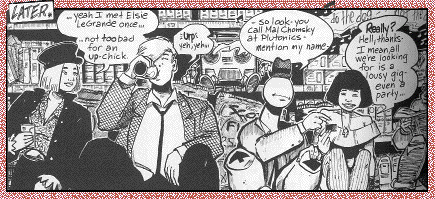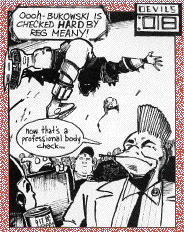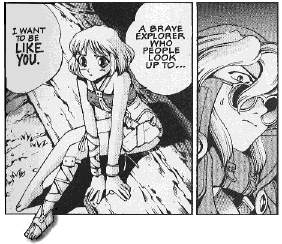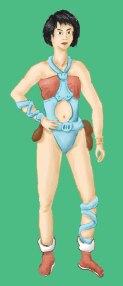

| October 1998 |
|
| Evan Dorkin: Hectic Planet | |
 So far as I'm concerned Dorkin's main role in life is to keep Sarah Dyer happy and productive; but he also does comics. Fency det.
So far as I'm concerned Dorkin's main role in life is to keep Sarah Dyer happy and productive; but he also does comics. Fency det.
He's probably best known for Milk and Cheese. Perhaps it only makes sense that this explosion of id comes from the consort of the perky, G-rated Dyer; it restores some sort of cosmic balance. M&C is generally amusing; Dorkin can draw; those enormous eyebrows are adorable, and the asides are good. One does want to ask, though-- what gave this white boy such rage?
As for Hectic Planet, it's punk sf, basically. It was originally called Pirate Corp$!, with an exclamation point so you know it's bang-bang shoot-em-up vroom socko fun! And it is, once you figure out who's who.
It's build around a 21st century pirate ship-- basically meaning a collection of interstellar misfits in the business of taking contraband from point A to point B. The captain is Ron, four-armed former pro hockey goalie and a worrywart; other crew members include melancholy Terran ska boy Halby; cheerful, purple, be-tailed, eyeless Blue-- also a ska freak; Harlie, a diminutive Yanmo warrior; Datsun, the mellow duck-faced medic; and the stowaways, miniature furry aliens with a tendency to eat the crew's personal hygiene products.
The first volume emphasizes lowlife adventure, and reads like Dorkin is trying hard to draw Really Cool Stuff-- transformerish robots, transformerish spacesuits, zippy spaceships, blood-drenched fights, badass aliens, big guns, dark glasses, kickin' dance clubs.
On a first reading, I liked it, but wished it was a little more coherent. Dorkin hasn't spent much time, to put it mildly, figuring out how this culture or this universe works-- why there's aliens all over, why they seem to have no cultures, languages, or technological differences, why an interstellar economy looks just like ours, why the kids are hot for music styles (and the clothing that goes with them) from a century ago. (I could add: and why is it cool in this future to wear ties? But that's actually kind of a neat touch.)
 But having it around on my desk for a couple of weeks and dipping into it at odd moments, it grew on me. Once you get past the veneer of coolness, you see the affection for the characters, the cute background details, the moments of surrealistic dark humor (e.g. the man seeking eternal youth whose face falls off into his soup).
But having it around on my desk for a couple of weeks and dipping into it at odd moments, it grew on me. Once you get past the veneer of coolness, you see the affection for the characters, the cute background details, the moments of surrealistic dark humor (e.g. the man seeking eternal youth whose face falls off into his soup).
The second volume (and the remaining comic issues, #5-6) focus more on the characters-- mostly on Hal, who's in a mess over breaking up with a girl, and figures that a good strategy for dealing with his loss is to be as much of a self-centered fuckup loser as he can.
If this sounds like Joe Matt, it's not, thanks largely to Dorkin's savage sense of humor. His suggestions for improving hockey are interesting-- e.g., two pucks, pneumatic puck launchers, and ultraviolence-- but his real masterpieces are two long set pieces, one about a supermarket the size of the Pentagon, the other about Blue's experiences sitting around a police station waiting to be booked. This part of the series has been aptly described (by Lots42) as "Clerks meets The Fifth Element".
The "explosion of id" theme returns in Vroom Socko: Paid in Full, a lovingly rendered tale of pure pornographic mayhem starring Ron's colleague Vroom, a man of big guns and very little brain.
Hey, did I mention that Dorkin can draw? His style is a little busy for B&W, but he draws great aliens, cute girls, and wonderful facial expressions.
| Akihito Yoshitomi: Eat-Man | |
 An oddly charming manga. Bolt is an 'explorer', wandering through a Moebius-like future, in a trenchcoat that seems to be mostly inexplicable straps and rivets, taking odd jobs-- defeating a dragon here, confronting a Devil King there. He's the perfect adventurer-hero: laconic, wandering, magnetic to women, projecting an air of cynical detachment, and yet always, when the time comes, doing the right thing. (Whether he knows it or not, this type of hero follows the biblical parable (Matthew 21:28): he says 'I will not', and yet he does it.)
An oddly charming manga. Bolt is an 'explorer', wandering through a Moebius-like future, in a trenchcoat that seems to be mostly inexplicable straps and rivets, taking odd jobs-- defeating a dragon here, confronting a Devil King there. He's the perfect adventurer-hero: laconic, wandering, magnetic to women, projecting an air of cynical detachment, and yet always, when the time comes, doing the right thing. (Whether he knows it or not, this type of hero follows the biblical parable (Matthew 21:28): he says 'I will not', and yet he does it.)

But Bolt's real charm is that he's always snacking-- on bolts and screws. He has the supernatural power to eat objects and reconstitute them later as (absurdly powerful) weapons. Oh, and he can catch bullets in his teeth. Ho hum, you say (and by the way, by what strange linguistic pathway did that come to represent a yawn?)-- Superman and twenty other superheroes can do that. Yeah, but they don't eat the bullet afterwards.
The one problem... I can't quite deal with Akihito's girls. Some of them are intended to be tough-- explorers-in-training, swordswomen-- but with one exception (Margot, in the last story) they're basically shrinking violets-- tiny, leggy, implausibly (half-)dressed, huge-eyed wimps. And it's not a cultural thing-- virtually any manga can produce Amazons that will whip these chicksticks: Ranma and Akane, the Dirty Pair, the chick from Crying Freeman, Nausicäa and Kushana, Motoko Kusanagi, even the Sailor Moon crew.
Just for fun, I drew my own interpretation of one of Bolt's dippy little chicks, Roan; compare with Akihito's version above left.
